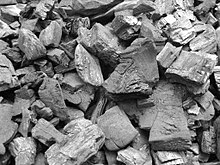Fossil record of fire

The fossil record of fire first appears with the establishment of a land-based flora in the
Fossil evidence

The fossil evidence of fire comes mainly from charcoal. The earliest charcoal dates to the Silurian period.[7] Charcoal results from organic matter exposed to high temperatures, which drives off volatile elements and leaves a carbon residue. Charcoal differs from coal, which is the fossilised remains of living plants and burns to leave soot.
Fossil charcoal is known as fusain, a crumbly silky material which may form blocks or microscopic films.[8] Plants can be preserved in exquisite detail, and original cell structures can often be preserved in three dimensions.[8] Spectacular images can be recovered using scanning electron microscopy.[9] Fragments can be distributed some distance, and soot-rich layers in strata deposited by deltas can provide a 'time-averaged' record of fire activity in the catchment (and up-wind) area of the river.[8]
The loss of volatile elements during combustion means that charred remnants are usually smaller than the original organism, but this same factor makes them unlikely to be eaten by any animals (for they have no nutritional value), enhancing their
Evidence of lightning strikes is usually difficult to link to specific fires; occasionally they may scorch trees, but
Geochemical evidence
The amount of oxygen in the atmosphere is the major control on the abundance of fire; this can be approximated by a number of proxies.[10]
Development through time
Fires among the low, scrubby, wetland plants of the Silurian can only have been limited in scope. Not until the forests of the Middle Devonian could large-scale wildfires really gain a foothold.[8] Fires really took off in the high-oxygen, high-biomass period of the Carboniferous, where the coal-forming forests frequently burned; the coal that is the fossilised remains of those trees may contain as much as 10-20% charcoal by volume. These represent fires which may have had approximately a 100-year repeat cycle.[8]
At the end of the Permian, oxygen levels plummeted, and fires became less common.
Fires again become significant in the late Jurassic through the Cretaceous. They are especially useful as charcoalified flowers provide a key piece of evidence for tracking the origin of the
Notes
- ^ From a Triassic tree in Antarctica
References
- PMID 10905606.
- .
- doi:10.1130/G20363.1.
- ^ PMID 16832054.
- ^ S2CID 22389421.
- JSTOR 3515337.
- doi:10.1130/G20363.1.
- ^ .
- PMID 16054859.
- PMID 11539776.
- .
Further reading
- McKenzie D, Gedalof Z, Peterson DL, Mote P (2004). "Climatic change, wildfire, and conservation" (PDF). Conserv Biol. 18 (4): 890–902. S2CID 54617780.
- Pausas JG, Keeley JE (2009). "A burning story: the role of fire in the history of life" (PDF). BioScience. 59 (7): 593–601. S2CID 43217453.
